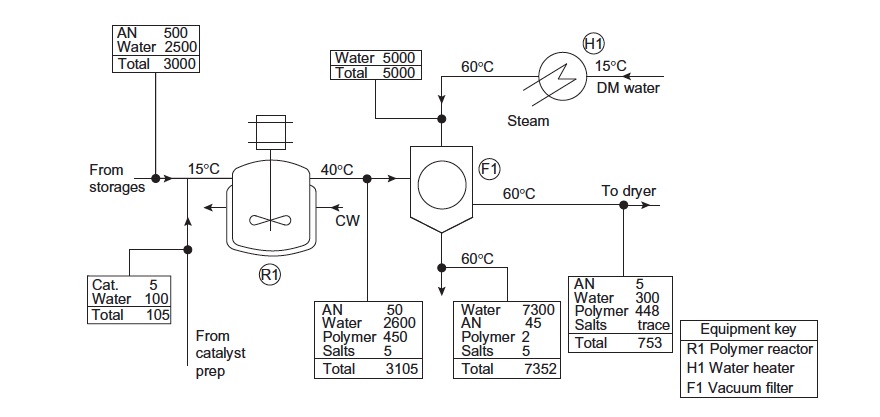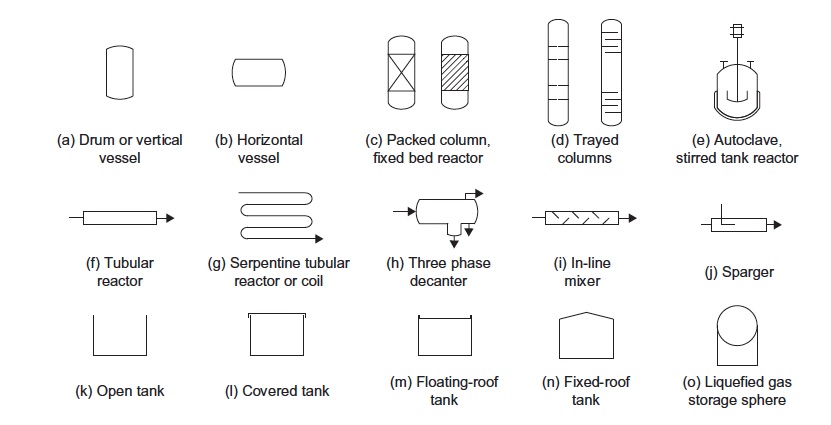Process flow diagram
Author: Tammy Wong [2015]
Stewards: Jian Gong and Fengqi You
Introduction
The process flow diagram (PFD) is a critical component of process design. It is absolutely necessary that chemical engineers know how to read process flow diagrams because it is the primary method of detailing the process and design information. Additionally, the most effective way of relaying information about a process design is the use of process flow diagrams. The PFD shows the sequence of flow through a system through the various equipment (such as piping, instrumentation, and equipment design) and details the stream connections, stream flow rates and compositions and operating conditions through the plant layout. The PFD differs from a block flow diagram (BFD) in that the PFD is more detailed and conveys more information than the BFD, which only gives a general sense of flow of information.
Overview
Essential Information That Must Be Included In A Process Flow Diagram
- Process vessels and equipment (such as heat exchangers, pumps, distillation columns, and reactors)
- Process piping
- Process and Utility Flow Lines
- Full heat and material balances
- Composition, flow rate, pressure and temperature of every stream
- Stream enthalpy
- Location of every control valve
- Sizing of pumps and compressors
- Bypass and recycle streams
Optional Information That Can Be incorporated In A Process Flow Diagram
- Molar percentage composition and/or molar flow rates
- Physical property data
- Mean values for stream
- Stream names
Categorization of Information In a Process Flow Diagram
The information that a process flow diagram conveys can be categorized into one of the following three groups:
- Process topology
- Stream information
- Equipment information
Process Topology
Process topology is defined as the interactions and locations of the different equipment and streams. It includes all of the connections between the equipment and how one stream is changed to another after it flows through a piece of equipment. It should be noted on a separate table following the PFD, the equipment on the must be labeled (it can be labeled with a number) and followed by a short description so that the engineer who is trying to understand the PFD will have a easier time following along.
Naming Equipment
Typical names for the equipment include a letter followed by a set of numbers. The letter usually corresponds to the first letter of the equipment. For example, the first pump in the PFD is typically labeled P-101. The following table displays the convention of naming the letters for process equipment:
- C-Compressor or Turbine
- E-Heat Exchanger
- H-Fired Heater
- P-Pump
- R-Reactor
- T-Tower
- TK-Storage Tank
- V-Vessel
- Y means that it is a specific area in the plant
- A/B identifies parallel units or backup units not shown on a PFD
Additionally, it should be noted that in a plant, certain equipment will need to be replaced. Typically, the new equipment will take the old equipment's name but an additional letter or number will be added onto the new equipment to indicate that there was a modification.
Symbols for Process Technology
For process equipment, there are a few standard symbols that should be recognized by chemical engineers. These symbols are displayed in the following figure: (Source Towler and Sinnott, Chapter 2, page 36)
Utility Streams in Process Topology
Utilities are necessary for the plant to keep running. The purpose of the utilities is usually to add or remove heat to the equipment so that the temperature can be controlled. There are many different types of utilities that can service a plant:
- Electricity
- Compressed Air
- Cooling Water
- Refridgerated Water
- Steam
- Condensate Return
- Inert Gas
- Flares
Stream Information
In small PFDs, stream information, including flow rates, temperatures, pressures, and compositions, are shown directly next to the PFD on a table. The corresponding number on the stream will be translated onto the table. The table is usually divided into two sections - one section for the essential information and one for the optional information.
Equipment Information
In addition to the stream information, there should also be a table detailing equipment information. This table can be helpful for the economical analysis of the plant. The equipment information table should include a list of all of the equipment that is used in that particular flow diagram along with a description of size, height, number of trays, pressure, temperature, materials of construction, heat duty, area and other critical information.
Process Flow Diagram Example
Example 1: Polymer Production
In the following figure about polymer production (taken from Towler and Sinnott, Chapter 2, page 38), the PFD contains a few pieces of equipment so that the corresponding streams can be placed on the figure itself instead of on a separate table. Please note that all streams are labeled with the temperature, the flow rate and amount of each composition, and on a separate table, all of the equipment is clearly defined with their names.

Sources
- Towler, G.P. and Sinnot, R. (2012). Chemical Engineering Design: Principles, Practice and Economics of Plant and Process Design.Elsevier.
- Biegler, L.T., Grossmann, L.E., and Westerberg, A.W. (1997). Systematic Methods of Chemical Process Design. Upper Saddle River: Prentice-Hall.
- Peters, M.S. and Timmerhaus, K.D. (2003). Plant Design and Economics for Chemical Engineers, 5th Edition. New York: McGraw-Hill.
- Seider, W.D., Seader, J.D., and Lewin, D.R. (2004). Process Design Principles: Synthesis, Analysis, and Evaluation. New York: Wiley.
